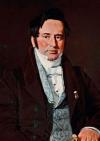Biography
Oehlenschläger and his sister Sofia were allowed their own way throughout their childhood, and were taught nothing, except to read and write, until their twelfth year. At the age of nine, Oehlenschläger began to make fluent verses. Three years later, while walking in Frederiksberg Gardens, he attracted the notice of the poet Edvard Storm, and the result of the conversation was that he received a nomination to the college called Posterity's High School, an important institution of which Storm was the principal. Storm himself taught the class of Scandinavian mythology, and thus Oehlenschläger received his earliest bias towards the poetical religion of his ancestors.
Oehlenschläger was confirmed in 1795, and was to have been apprenticed to a tradesman in Copenhagen. To his great delight there was a hitch in the preliminaries, and he returned to his father's house. He now, in his eighteenth year, suddenly took up study with great zeal, but soon again abandoned his books for the stage, where he was offered a small position. In 1797 he made his appearance on the boards in several successive parts, but soon discovered that he possessed no real histrionic talent. The brothers Ørsted, with whom he had formed an intimacy that proved quite profitable to him, persuaded him to quit the stage, and in 1800 he entered the University of Copenhagen as a student. He was doomed, however, to disturbance in his studies, first from the death of his mother, next from his inveterate tendency towards poetry, and finally from the First Battle of Copenhagen in April 1801, which, however, inspired a dramatic sketch (April the Second 1801) which is the first thing of the kind by Oehlenschläger that we possess.
In the summer of 1802, when Oehlenschläger had an old Scandinavian romance, as well as a volume of lyrics, in the press, the young Norse philosopher, Henrik Steffens, came back to Copenhagen after a long visit to Schelling in Germany, full of new romantic ideas. His lectures at the university, in which Goethe and Schiller were revealed to the Danish public for the first time, created a great sensation. Steffens and Oehlenschläger met one day at Dreier's Club, and after a conversation of sixteen hours the latter went home, suppressed his two coming volumes, and wrote at a sitting his splendid poem Guldhornene, in a manner totally new to Danish literature. The result of his new enthusiasm speedily showed itself in a somewhat hasty volume of poems, published in 1803, now chiefly remembered as containing the lovely piece called Sanct Hansaften-Spil.The next two years saw the production of several exquisite works, in particular the epic of Thors Reise til Jotunheim, the charming poem in hexameters called Langelandsreisen, and the bewitching piece of fantasy Aladdin (1805). At the age of twenty-six, Oehlenschläger was universally recognized, even by the opponents of the romantic revival, as the leading poet of Denmark. He now collected his Poetical Writings in two volumes. He found no difficulty in obtaining a grant for foreign travel from the government, and he left his native country for the first time, joining Steffens at Halle in August 1805. Here he wrote the first of his great historical tragedies, Hakon Jarl, which he sent off to Copenhagen, and then proceeded for the winter months to Berlin, where he associated with Humboldt, Fichte, and the leading men of the day, and met Goethe for the first time.
In the spring of 1806 he went on to Weimar, where he spent several months in daily intercourse with Goethe. The autumn of the same year he spent with Tieck in Dresden, and proceeded in December to Paris. Here he resided eighteen months and wrote his three famous masterpieces, Baldur hin Gode (1808), Palnatoke (1809), and Axel og Valborg (1810). Oehlenschläger had also made his own translation of Aladdin into German, adding some extra new material which does not appear in the 1805 edition; this revised version was published in Amsterdam in 1808. Ferruccio Busoni later used the text of this translation for the last (choral) movement of his Piano Concerto Op. 39. Later editions of Oehlenschläger's play do not contain this text.
In July 1808 he left Paris and spent the autumn and winter in Switzerland as the guest of Madame de Staël at Coppet, in the midst of her circle of wits. In the spring of 1809 Oehlenschläger went to Rome to visit Bertel Thorvaldsen, and in his house wrote his tragedy of Correggio. He hurriedly returned to Denmark in the spring of 1810, partly to take the chair of aesthetics at the University of Copenhagen, partly to marry the sister-in-law of Rahbek, to whom he had been long betrothed. His first course of lectures dealt with his Danish predecessor Johannes Ewald, the second with Schiller. From this time forward his literary activity became very great; in 1811 he published the Oriental tale of Ali og Gulhyndi, and in 1812 the last of his great tragedies, Stærkodder.






